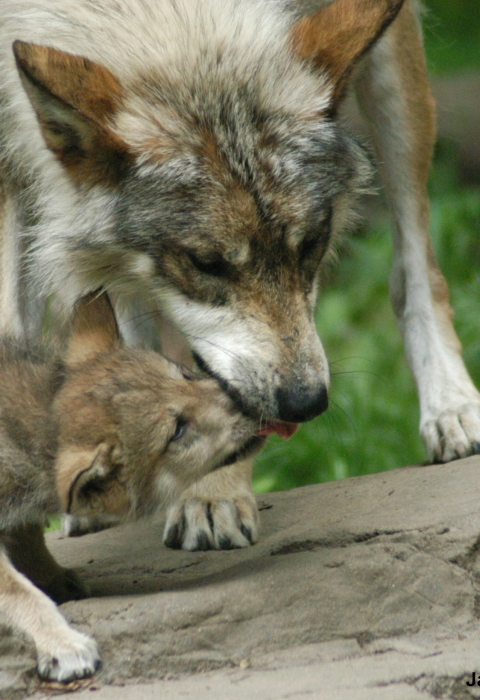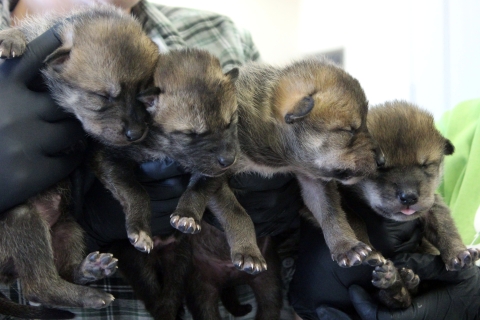What is fostering?
Fostering is an innovative technique used by the Mexican Wolf Recovery Program to increase genetic diversity in wild Mexican wolf population in the United States. Fostering begins with carefully managed breeding by the Mexican Wolf Saving Animals From Extinction (SAFE) program to produce genetically diverse pups within the captive population. Within 14 days of whelping (being born), the captive-born pups are transported to the wild and mixed together with similarly aged wild pups. The surrogate wild wolf parents raise the new pups as if they were a part of the original litter. These surrogate parents are usually experienced and have successfully raised litters in the past.
How it works
Fostering begins every year with careful planning. The Mexican Wolf Recovery Program coordinates closely with the Saving Animals from Extinction (SAFE) program to determine how many and which pairs of Mexican wolves in captivity will breed. During the breeding season (Jan-March), captive pairs are monitored for breeding activity (copulatory breeding tie), from which whelping dates (having pups) are projected out.
Once pups in captivity are born, the Mexican Wolf Interagency Field Team works to find wild dens for the pups to go into. The foster and wild pups need to be born within 8 days of each other, and all pups need to be younger than 14 days for fostering to occur. Additionally, the field team tries to foster into wild dens where the female has experience raising pups.
The day of a foster operation, staff begin working before dawn to pull the desired number of captive pups from their den. The captive female is usually left with one or two pups from the litter to care for, allowing a maximum number of pups to be sent to the wild.
The pups are then flown, sometimes across great distances, to New Mexico or Arizona. While in transit, they are cared for by veterinary staff who will tube feed the pups and keep them warm. Upon landing, they are handed over to Mexican wolf field team staff who transport them to their new home in the wild.
In the wild, field team staff locate the den in the wild and pull all the wild pups out. When the captive-born pups arrive, they are mixed together with the wild pups. This includes having them urinate and defecate on each other, so that they all smell the same. All the pups are swabbed for DNA, given studbook numbers and vaccinated. The new mixed litter is then placed back inside the den. The breeding female will return to the den, move all the pups to a new location, and raise the captive and wild-born pups together.
Why genetics matter
All wild and captive Mexican wolves in the U.S. and Mexico are descended from only seven founding individuals. The captive population of Mexican wolves has more genetic diversity than is currently represented in the wild. While the wild population has shown a healthy growth trajectory for more than a decade, continued releases from captivity are necessary to address genetic threats.
The 2022 Recovery Plan establishes genetic criteria to ensure that gene diversity available from the captive population has been incorporated into the wild population. This is accomplished through releases of a sufficient number of wolves to ensure that 22 released wolves survive to breeding age (i.e., a pup that lives to age 2 or an adult that lives for a year following its release).
Fostering has been determined to be a less controversial technique can accomplish these goals as releases of adults from captivity. It does not require putting wolves into new areas on the landscape, but rather adds numbers to existing packs within an established home range. Also, the pups are raised as wild wolves, with all the skills and knowledge needed to survive, including a natural fear of humans.
Foster Successes
- Fostering has proven successful, with a minimum of 18 pups surviving to two years of age (from 83 fosters released between 2016 and 2022).
At least ten fostered wolves have successfully bred and produced litters in the wild. Fostered Mexican wolves have produced more than 20 litters and several of those offspring have gone on to produce pups of their own.
Connected by Conservation
The Mexican wolf fostering program is built on partnerships.
The SAFE program has invested significant resources to provide genetically valuable pups for fostering year after year. Today, there are more than 350 Mexican wolves housed at SAFE facilities. In addition to caring for their wolves with unparalleled dedication, these facilities have served as ambassadors for wolf recovery across the U.S. and Mexico, connecting people of all backgrounds to the conservation work happening here in the Southwest.
LightHawk has stepped in to provide flights to transport pups across the country. These pilots have generously donated their time, expertise, fuel and aircraft in support of fostering. These flights help reduce the amount of time pups are under human care, which in turn helps maximize the chance of survival in the wild.
The Interagency Field Team plan and implement foster efforts in the wild. They monitor the wild population for denning activity, locate dens in the wild to foster into, coordinate and communicate fostering efforts within the recovery area, provide food caches to support packs with fosters, and work to document foster survival throughout the year.
Partners in Mexican wolf recovery in the United States include the Service, Arizona Game and Fish Department, New Mexico Department of Game and Fish, U.S. Department of Agriculture (USDA) Forest Service, USDA APHIS Wildlife Services, White Mountain Apache Tribe, Bureau of Land Management, National Park Service, and the Saving Animals From Extinction program.








